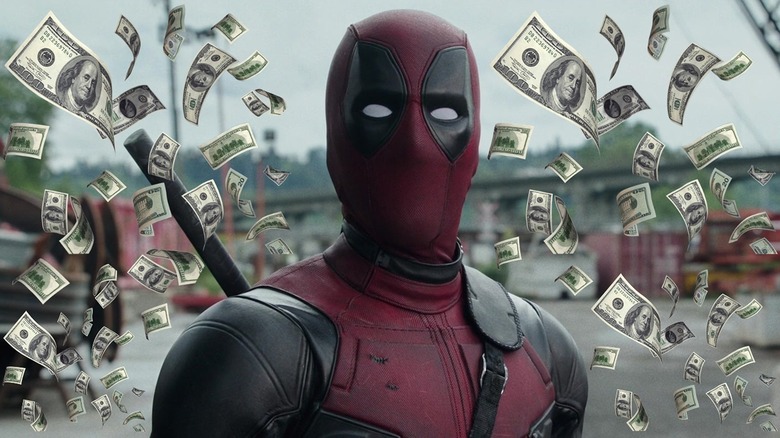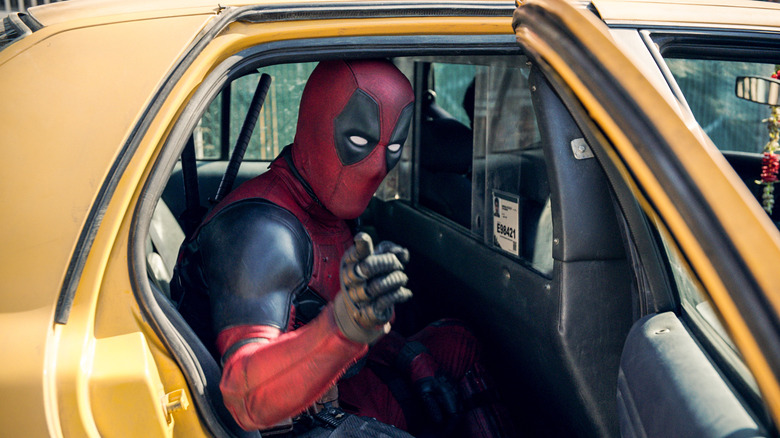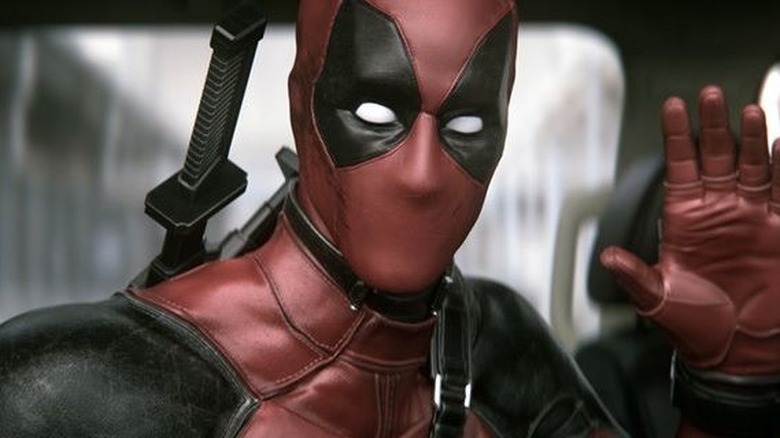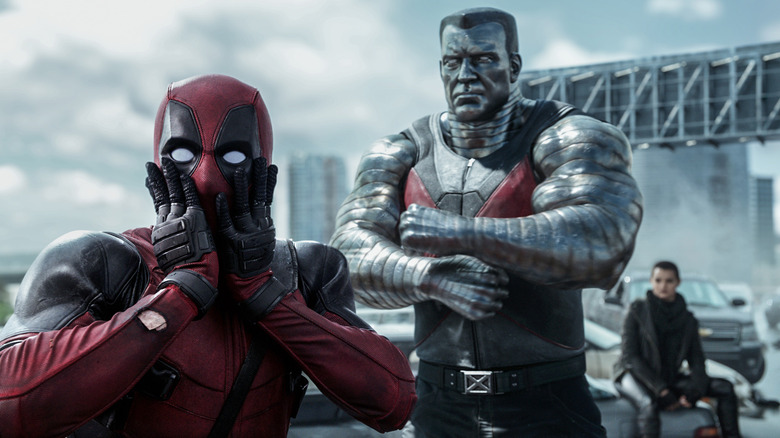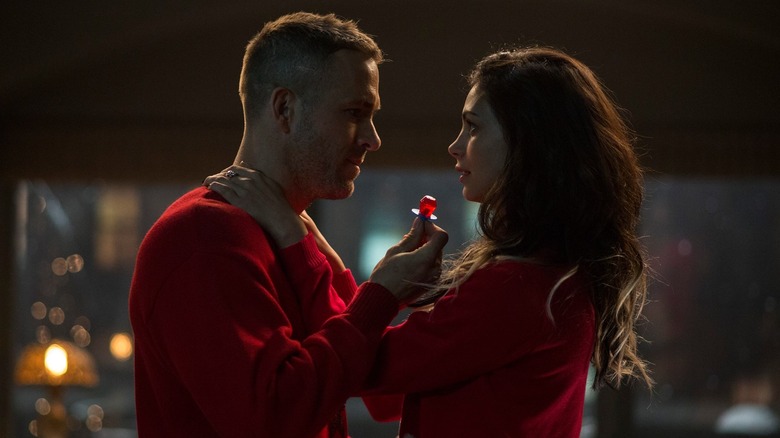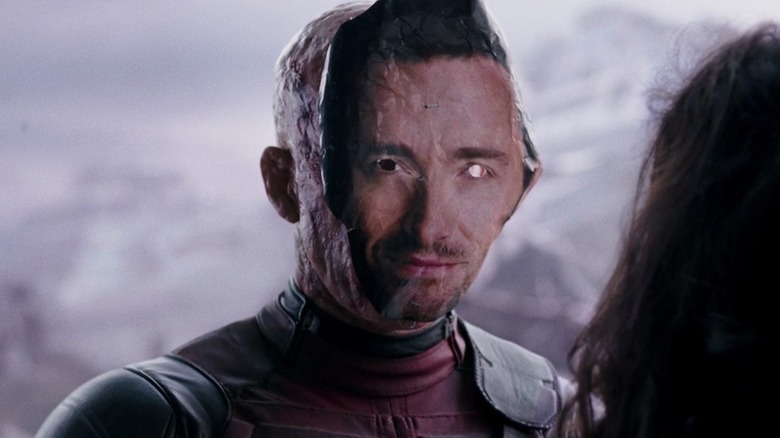Deadpool Broke Box Office Records By Breaking The Marvel Mold
(Welcome to Tales from the Box Office, our column that examines box office miracles, disasters, and everything in between, as well as what we can learn from them.)
"I remember reading one of the Deadpool comic books, and somebody asked Deadpool what he looks like. He said he looks like a cross between a Shar-Pei and Ryan Reynolds. I was like, I really, really wanna play this guy at some point," Reynolds said in 2009 of playing Deadpool. The actor, then known for his roles in films like "Van Wilder" and "Just Friends," would end up playing the part multiple times, but the journey to get a proper "Deadpool" movie made was a rough one that took well over a decade. It became a passion project for Reynolds that he championed every step of the way, ultimately resulting in one of the biggest R-rated movies in history.
Development on "Deadpool" dates back to at least 2004 when David S. Goyer wanted to work with Reynolds again after their collaboration on "Blade: Trinity." Things stalled out on the solo film, but Fox decided that including the character in 2009's "X-Men Origins: Wolverine" was a good idea. "At that point, I was under the impression that it was 'either play Deadpool in this iteration or someone else will.' So, of course, I signed on," Reynolds later explained of the ultimatum he was presented with. That movie presented us with a disastrous version of the fan-favorite Marvel character, only serving to make what happened later all the more incredible.
In this week's Tales from the Box Office, in honor of the success of "Deadpool & Wolverine," we're looking back at 2016's "Deadpool." We'll go over the film's long development journey, how some leaked test footage essentially forced Fox to give it the green light, what happened when the film hit theaters, how it changed the superhero landscape, and what lessons we can learn from it nearly a decade later. Let's dig in, shall we?
The movie: Deadpool
The movie as we know it is a lean, relatively low stakes (for a superhero movie), isolated, R-rated adventure focused on Wade Wilson (Reynolds), a former Special Forces operative working as a mercenary. After being diagnosed with cancer, he signs up for an experimental treatment meant to unlock mutations in people headed up by Ajax (Ed Skrein), with the process leaving Wade with powers, but also disfigured and scarred. Using his new skills, Wade hunts down the man who ruined his life.
Fox was pretty hot on Reynolds as the character, in theory anyway, officially announcing development of a "Deadpool" movie in 2009. Things got complicated once "Origins" arrived to dismal reviews. Fans were vocally unhappy with the version of Deadpool we got in that film, complicating matters for a spin-off. In the world of Marvel Comics, the character that Rob Liefeld and Fabian Nicieza created in the early '90s is often portrayed as a foul-mouthed, fourth-wall-breaking, murderous ball of mischief. "Origins" sewed his mouth shut in the third act. It was a far cry from what fans — and Reynolds — had in mind.
The project languished in development hell, with rumors or wishy-washy quotes from those involved popping up from time to time. A most intriguing bit came from Liefeld in 2012 when the comic book creator revealed that test footage for a "Deadpool" movie had been shot, and he made it sound like the movie everyone wanted in the first place:
"I may or may have not seen some sort of test footage that would blow your mind if you saw it and go holy crap and that's Deadpool in costume. Katana swords, guns, shooting people's faces off and making me laugh. I may or may not have seen something that looks just like that. You've got what would amount to the first R Rated X-Men movie. Because that script is R Rated. They may or may not have wanted to shoot eight minutes to see how it would play."
The Deadpool test footage mysteriously leaks
A couple of years later, the "Deadpool" test footage was leaked online in the summer of 2014. The sequence was created several years earlier in 2011 with the then-unknown Tim Miller of Blur Studios behind the camera. The footage took the internet by storm, showcasing a comics-accurate version of the Merc With a Mouth taking down bad guys in an epic freeway chase. Even though the leaked footage was brief, the internet went absolutely nuts for Reynolds' take on the character.
The reaction essentially forced Fox's hand, and mere weeks later on September 18, 2014, the studio officially announced a "Deadpool" movie with Miller directing for a 2016 release. Rhett Reese and Paul Wernick ("Zombieland") were tapped to pen the screenplay. In 2015, Reynolds made it crystal clear why the movie finally got the green light. "Leaked test footage. Exclusively the leaked test footage, 100 percent." As for who leaked the footage? That remains a question to this day, but here's what Reynolds said at the time:
"I would have, if I had known it would have caused that! Honestly, we all thought Tim Miller, the director, had leaked it. But I have since investigated that enough, in quiet moments when he was beyond the point of being penalized by anybody, and he said that he really didn't do it. The initial [leak] came from Fox they think — someone recorded the footage on their iPhone and then released it. Then once that happened, somebody hacked into Blur Studios and got the original footage in high-res and put it online."
Fox was undoubtedly unhappy about the leak, but it was clear that there was a sizable audience for this film. The tone of the footage was very R-rated, which is something that hadn't been done in the "X-Men" universe up to that point. Mind you, dating back to the breakout success of "X2" in 2004, this had become a cash cow franchise for the studio. Going with a hard R was risky.
Making Deadpool R-rated was not an easy task
Filming began in March 2015, six years after "Origins" hit theaters. Even though Fox gave the film a green light, they didn't make things easy behind the scenes. Rumors swirled that they got the green light because they were willing to make a PG-13 version. Fortunately, in July 2015, "X-Men" franchise producer Simon Kinberg confirmed that they were going R-rated. "Deadpool is a hard R. It's graphic. Nothing is taboo. You either commit to a truly outrageous boundary-pushing kind of movie or you don't."
As for locking down the story, Reese explained in a Blu-ray featurette that it was Reynolds who stepped in to make "Deadpool" an origin story:
"We originally pitched a non-origin story, interestingly, just a Deadpool adventure. We pitched to Ryan Reynolds and he enjoyed the pitch, but he was pretty emphatic about the fact that it had to be an origin story. So ultimately what happened was, we kind of melded the two."
Reese and Wernick cracked that story with Reynolds while he was filming a different superhero film, 2011's box office bomb "Green Lantern," for DC. "What a lot of people don't know is [writers Rhett Reese and Paul Wernick] flew to New Orleans and, while I was shooting 'Green Lantern,' we were actually all together writing 'Deadpool,'" Reynolds explained in a 2017 interview.
Even as production rolled on, the crew was forced to make aggressive cuts to meet strict budget demands made by Fox. "Deadpool" had a $58 million budget, which was less than half of what the average superhero movie cost at the time. As a result, major sacrifices had to be made, including slashing $7 million from the budget at the last minute. That involved trimming action sequences, cutting characters and even a big gunfight. As Reese explained to Gizmodo in February 2016:
"We had a big, big gun fight in the third act that we took out and we basically had Deadpool forget his guns as a means of getting around it. So there were just reductions."
The financial journey
One crucial factor to the film's financial success is that Fox launched an all-timer of a marketing campaign for "Deadpool," with Reynolds leading the way. The actor has since proven himself an asset in this area time and time again, from promoting his own Aviation Gin to Mint Mobile. The man knows how to market a thing. "That was the thing that I think was particularly unusual about 'Deadpool' is that the marketing campaign was a direct extension of the film itself," Reynolds later said.
Early tracking numbers for the $58 million film were incredibly kind, with the film expected to earn around $78 million on its opening weekend domestically. It would end up doing nearly double those estimates. "Deadpool" hit theaters on February 12, 2016, against "How to Be Single" and Ben Stiller's "Zoolander 2," which turned out to be a big flop. At the very least, they did nothing to get in the way of this "X-Men" spin-off, as the film opened to a then-record $132.4 million. That number ballooned to $152.1 million when accounting for the Presidents Day holiday. It was the first time an R-rated movie ever cleared $100 million on opening weekend, proving that superheroes didn't have to play in the PG-13 sandbox after all.
The film played like gangbusters overseas as well, in no small part thanks to incredibly favorable reviews from critics and audiences alike. All told, "Deadpool" pulled in $363 million domestically to go with $419.5 million internationally for a grand total of $782.6 million. Or, to put it another way, roughly 13.5 times its production budget. Naturally, "Deadpool 2" was green lit in short order, with the sequel going on to make $734.5 million in its original run. A billion-dollar franchise born from several minutes of leaked test footage. Not bad.
The lessons contained within
"Deadpool" gave the "X-Men" franchise its biggest opening weekend ever up to that point. More than that, it represented the biggest opening weekend in the history of Fox. That's still hard to wrap one's head around. That level of success opened the door for some major reinvention in the realm of comic book movies, with 2017's "Logan" also going the R-rated route and becoming 1) hugely successful, and 2) one of the most roundly-praised comic book adaptations ever made. That may not have happened without this movie paving the way.
What Miller, Reynolds, and the seemingly reluctant brass at Fox accomplished was expanding the scope of what a Marvel movie could be. By 2016, we were more than 15 years into the superhero boom that exploded in the early 2000s thanks to "Blade," "X-Men," and "Spider-Man." There was a real need to expand the scope of what these movies could do. Taking off the PG-13 guardrails and telling a smaller story that was very true to the character in question felt like a revelation in that moment.
At a time when the superhero genre feels like it could use another reinvention, it's worth reflecting on how "Deadpool" accomplished that. Recent films like "Ant-Man and the Wasp: Quantumania," "The Marvels," "The Flash," and "Shazam! Fury of the Gods" all disappointed greatly at the box office. They were all also very expensive, over-crowded, and relatively complicated. The reliance on continuity and going bigger is beginning to hurt these films.
Perhaps the best way to move forward would be to scale back a bit. Don't be afraid to tell a smaller story. Don't be afraid to take real risks. Don't be afraid to color outside the lines. It's the only way to keep things fresh. Superhero stories are only limiting if the powers that be limit what they can be.
